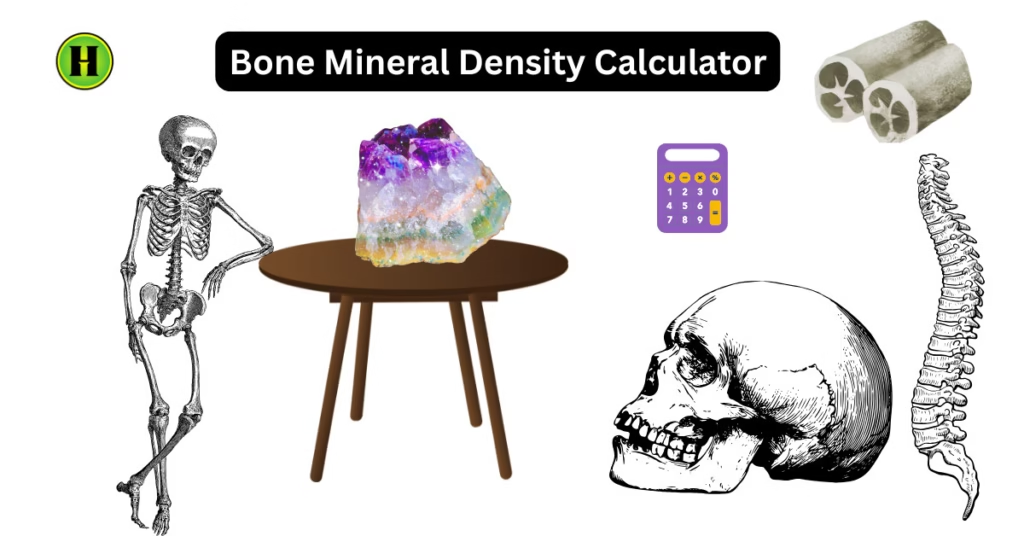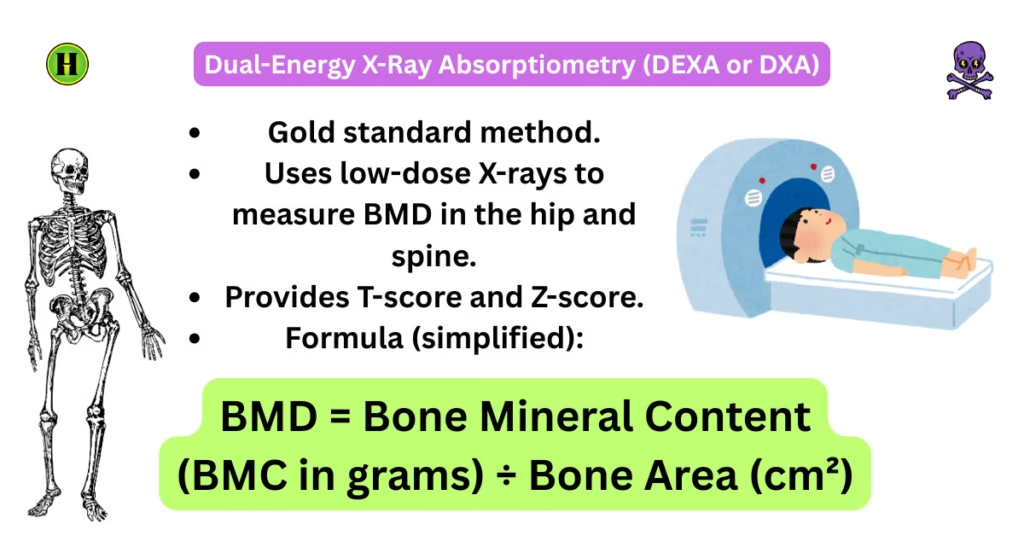Bone Mineral Density

When it comes to Bones, Everybody seeks good and strong bone health till death and Bone health is a vital aspect of overall wellness. One of the most effective ways of measuring Bone strength is Bone Mineral Density. A Bone Mineral Density Calculator calculates an exact bone strength and the chances of conditions happening like osteoporosis and osteopenia for any individual.
The Bone Mineral Density Calculator specifically evaluates the amount of calcium and minerals present in your bones. This may give a clearer picture of bone quality and risk of fracture.
In this article, let’s learn:
What is Bone Mineral Density (BMD)?
(BMD) Bone Mineral Density is defined as an amount of minerals that are of (mostly calcium and phosphorus) present inside the bone. It is usually measured in grams per centimeter square (g/cm²).
A person with higher Bone Mineral Density are with good strength, health, and power in their bones, and A low Bone Mineral Density indicates a higher risk of bone thinning, fractures, and osteoporosis.
Why is Measuring BMD Important?
- BMD is good procedure to measure osteoporosis.
- It can easily know the bone power and which can be more helpful for detecting the risk of fractures.
- Tracking bone health: Helps monitor the effects of medication or lifestyle changes.
- Preventive health: Early detection means timely prevention of bone loss.
Calculation Methods for BMD
1. Dual-Energy X-Ray Absorptiometry (DEXA or DXA)

2. Quantitative Ultrasound (QUS)

3. Quantitative Computed Tomography (QCT)

4. Peripheral Devices

Interpreting BMD Results

How Does the Healthmole BMD Calculator Work?
Our Bone Mineral Density Calculator will work as below stated:
- Our calculator asks the inputs such as age, gender, weight, height, Wrist Circumference, grip strength and Activity Level.
- After entering these units in metric or imperial , click on calculate button and the results are shown in below block section of the calculator.
- It ptovidesa you an exact BMD score and you can analyze your bone health status and guide you whether your score falls into the normal, osteopenia, or osteoporosis range.
Key Risk Factors for Low BMD
- Age (risk increases after 40, especially in post-menopause in women).
- Genetics (a family history of osteoporosis may affect hierarchy).
- Nutrition (low calcium and vitamin D intake will lead to low BMD).
- Lifestyle (smoking, alcohol consumption, and sedentary life will lower your BMD).
- Medical conditions (thyroid issues, rheumatoid arthritis will come to you if there is low BMD).
- Medications (steroids, chemotherapy drugs usage leads to low BMD).
Prevention & Management of Low BMD
- Nutrition intake must be good. So, Eat calcium-rich foods such as dairy products, leafy green vegetables, and fortified foods.
- Try to regularly expose your body in morning and evening sunlight to get Vitamin D from our Sun.
- Do weight-bearing exercises like walking, running, karate, martial arts, and yoga training for better improvement of bone mineral density.
- Don’t smoke cigarettes, weed, and don’t consume any alcohol or drugs and be active from your inner mental decision.
- Medical treatments like Bisphosphonates, hormone therapy may help you manage your BMD if prescribed.
Comparison with Other Health Calculators
- BMI vs BMD: BMI can only measure your body mass with weight and height , but not Bone Moneral Density.
- LBM vs BMD: Lean Body Mass can detect only muscle/fat balance, But BMD calculator finds your bone strength.
- Waist to hip ratio and Waist to Height ratio vs BMD: Waist ratios of both calculators finds only fat distribution, not bone density.
This makes Healthmole’s (BMD) Bone Mineral Density calculator uniquely valuable in osteoporosis prevention and keeps you strong.
Frequently Asked Questions
It’s an online tool that estimates your bone strength and osteoporosis risk using scientific formulas and health data.
A normal T-score is -1.0 or above.
DEXA scans use minimal radiation and are considered very safe.
Yes, through exercise, calcium/vitamin D intake, and lifestyle changes.
Postmenopausal women, men over 50, and anyone with risk factors.
Yes, extremely low or high body weight can have a negative impact on BMD.
Diet helps but must be combined with exercise and lifestyle adjustments.
Every 1–2 years if you’re at risk, otherwise as recommended by your doctor.
BMC (Bone Mineral Content): Total grams of minerals in bone.
BMD (Bone Mineral Density): BMC divided by bone area.
Only estimation is possible with calculators. Precise measurement needs devices like DEXA.
Conclusion
The Healthmole’s Bone Mineral Density (BMD) Calculator is an essential and important tool for knowing bone health and preventing osteoporosis before it becomes a serious problem for everyone. By combining modern interesting formulas with input data, the Healthmole BMD Calculator empowers users to take proactive and advance steps in maintaining skeletal strength.
Strong bones are the foundation of a healthy, funny, happy and active life. Use our Bone Mineral Density estimator calculator regularly, adopt bone-healthy habits, and consult your doctor for professional advice and guidance.
References
- Bone Mineral Density: Clinical Relevance and Quantitative Methods
- Dual-Energy X-Ray Absorptiometry
- The role of DXA bone density scans in the diagnosis and treatment of osteoporosis
- High prevalence of low bone mineral density in middle-aged adults in Shanghai: a cross-sectional study
- The clinical necessity of a distal forearm DEXA scan for predicting distal radius fracture in elderly females: a retrospective case-control study
- Bone Mineral Density and Its Determinants: A Systematic Review of Risk Factors and Prevention Strategies